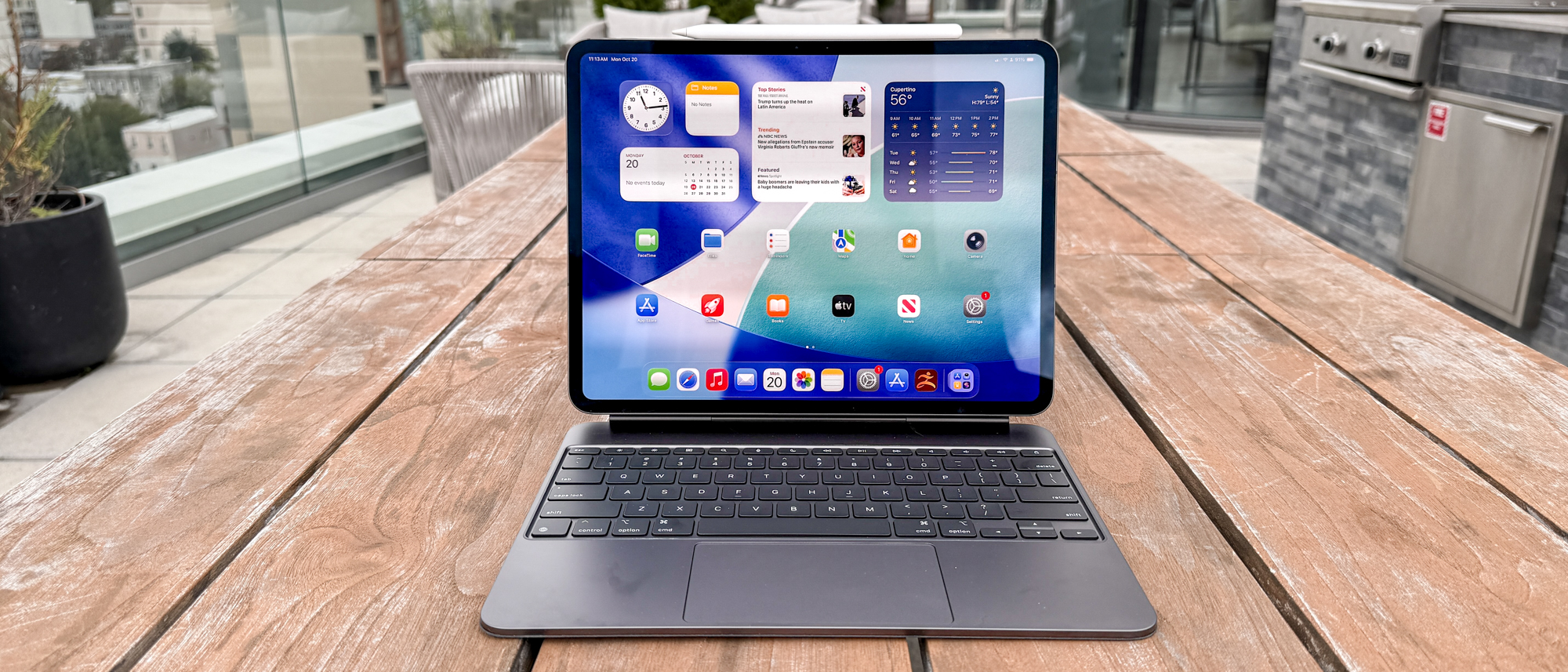Tom's Guide Verdict
The iPad Pro M5 features the same elegant lightweight design and beautiful OLED panel as its predecessor. Though it’s not a substantial upgrade, the fast M5 performance and more productivity-oriented iPadOS 26 make this the most powerful and useful iPad Pro yet. Just be prepared to pay a premium for peripherals and upgrades.
Pros
- +
Strong M5-driven performance
- +
Sturdy, lightweight design
- +
Gorgeous OLED panel
- +
Fast Wi-Fi 7 and Bluetooth 6 connectivity
- +
Long-lasting battery life
Cons
- -
Expensive peripherals and updates
Why you can trust Tom's Guide
The new iPad Pro M5 ($999 to start) might not be a revolutionary upgrade from the iPad Pro M4, but it’s still one of the best iPads and best tablets out there. This year’s model has everything I loved about the previous slate, only with better performance and some nice productivity updates via iPadOS 26.
Apple’s new M5 chip is the biggest upgrade for the iPad Pro. This powerful processor allows the tablet to run graphically demanding games and video editing software with ease. And if you’re not a power user, you’ll still enjoy how fast you can surf the web and switch between apps.
As before, the iPad Pro features an Ultra Retina XDR OLED panel that delivers stunning image quality. You’ll enjoy deep blacks and bright whites thanks to the 2,000,000:1 contrast ratio, with everything appearing sharp and crisp at 2,360 x 1,640 resolution. I said the OLED panel on the previous model was mesmerizing, and the same is true for the new iPad Pro.
Both the 11- and 13-inch iPad Pros are thinner and lighter than the current iPad Air M3 models. Don’t let that fool you into thinking the Pro tablets are fragile, as both are sturdy pieces of aluminum. Thanks to their lightweight design, even the 13-inch iPad Pro I reviewed is comfortable to hold for extended periods.
While upgrading to a configuration with nano-texture glass and purchasing peripherals like the Apple Magic Keyboard is expensive, the iPad Pro M5 still delivers a premium tablet experience. But is it for you? Let's get into it.
iPad Pro M5 review: Cheat sheet
- What is it? The new iPad Pro delivers improvements over its predecessor, including the faster M5 chip, increased RAM, Wi-Fi 7 and Bluetooth 6 support and faster cellular data. It retains the same lightweight design and tandem OLED panel we’ve come to love.
- Who is it for? The iPad Pro M5 is for those who need a tablet with MacBook Pro-like performance for demanding tasks like video editing. It’s also for anyone willing to pay a premium for an Apple tablet with an OLED panel.
- How much does it cost? The iPad Pro starts at $999 for the 11-inch model and $1,299 for the 13-inch variant on Apple’s website. Both models start at the same price as their respective predecessors.
- What do we like? We like the fast and powerful M5-driven performance, gorgeous tandem OLED panel, long battery life, and productivity-friendly iPadOS 26.
- What don’t we like? It’s not a significant upgrade from last year’s iPad Pro M4 and its improved AI features might not be useful to most users.
- Anything else I should know? Like last year, iPad Pro M5 models with 1TB or more of storage get the full-powered M5 with a 10-core CPU and 10-core GPU, along with 16GB of RAM. However, iPad Pro models with less than 1TB of storage come with only 12GB of RAM and a 9-core CPU on the M5, so they will likely perform slightly worse than the 1TB model I reviewed.
iPad Pro M5 review: Specs
| Row 0 - Cell 0 | iPad Pro M5 (starting) | iPad Pro M5 (tested) |
Price | from $999 | $2,099 |
Display | 11-inch Tandem OLED (2420 x 1668 pixels) | 13-inch Tandem OLED (2752 x 2064 pixels) |
Colors | Silver, Space Black | Silver, Space Black |
Chip | M5 (9-10 CPU cores, 10 GPU cores) | M5 (10 CPU cores, 10 GPU cores) |
RAM | From 12GB | 16GB |
Storage | 256GB | 1TB |
Cameras | 12MP front landscape, 12MP rear | 12MP front landscape, 12MP rear |
Wireless | Wi-Fi 7, 5G, Bluetooth 6 | Wi-Fi 7, 5G, Bluetooth 6 |
Size | 9.83 x 6.99 x 0.21 inches | 11.09 x 8.48 x 0.2 inches |
Weight | 0.98 pounds | 1.28 pounds |
iPad Pro M5 review: The ups
The iPad Pro M5 features the same lightweight design, gorgeous OLED and long-lasting battery life of its predecessor. The main upgrade is the powerful M5 chip, along with faster Wi-Fi 7 and the more MacBook-like iPadOS 26.
Fast M5-driven performance

The 13-inch iPad Pro that Apple sent us packs an M5 chip with a 10-core CPU, a 10-core GPU, 16GB of RAM and a 1TB SSD. Our model doesn’t have nano-texture glass, but it does feature Wi-Fi + Cellular. Altogether, this review unit is valued at $2,099 as configured.
Get instant access to breaking news, the hottest reviews, great deals and helpful tips.
Similar to the M4 chip, the new M5 processor utilizes 3nm technology, hardware-accelerated mesh shading, ray tracing and Dynamic Caching. Those latter features are no longer new for iPad Pro, but it’s good to see them return since they help deliver richer graphics, especially in video games. The M5 chip might not be a giant improvement over its predecessor, but the performance and graphical gains are noticeable.
Like I did with the previous iPad Pro, I used this slate as a laptop and a tablet, and it deftly handled my average workflow, which includes juggling numerous apps and tabs. The M5 chip’s performance plays its part, but so does iPadOS 26, which has been redesigned to be more productivity-friendly than ever—as I wrote about when I replaced my MacBook with an iPad Pro for a month. Doing less demanding tasks like watching YouTube or reading digital comics is also seamless.
| Row 0 - Cell 0 | iPad Pro M5 | iPad Pro M4 | Samsung Galaxy Tab S11 Ultra |
Geekbench (single-core) | 4,155 | 3,700 | 2,811 |
Geekbench (multi-core) | 16,517 | 14,523 | 9,126 |
3D Mark Wild Life Extreme Unlimited | 9,934 / 59 fps | 8,529 / 51 fps | 6,575 / 39 fps |
I expected the iPad Pro to do well in our benchmark tests, and I wasn’t disappointed. On Geekbench 6, which tests overall CPU performance, the M5 iPad Pro delivered an uplift of 12.3% and 13.7% in single- and multi-core performance respectively. Those performance gains are on par with what I’ve seen gen over gen for the M-series chips.
I fired up Resident Evil 4 Remake on the iPad Pro M5 and it ran relatively well. I say “relatively” since it clearly wasn’t running at 60 frames per second. Though I didn’t have a way to see the game’s exact frame count, it appeared to be at around 30 frames per second to my eyes.
We ran the 3D Mark gaming benchmark tool on iPad Pro. On the Wildlife Extreme Unlimited test, it scored better and saw higher frames per second than the M4 iPad Pro. These results corroborate my experience. In short, the new iPad Pro is a capable gaming machine, especially for games optimized for the M5 chip.
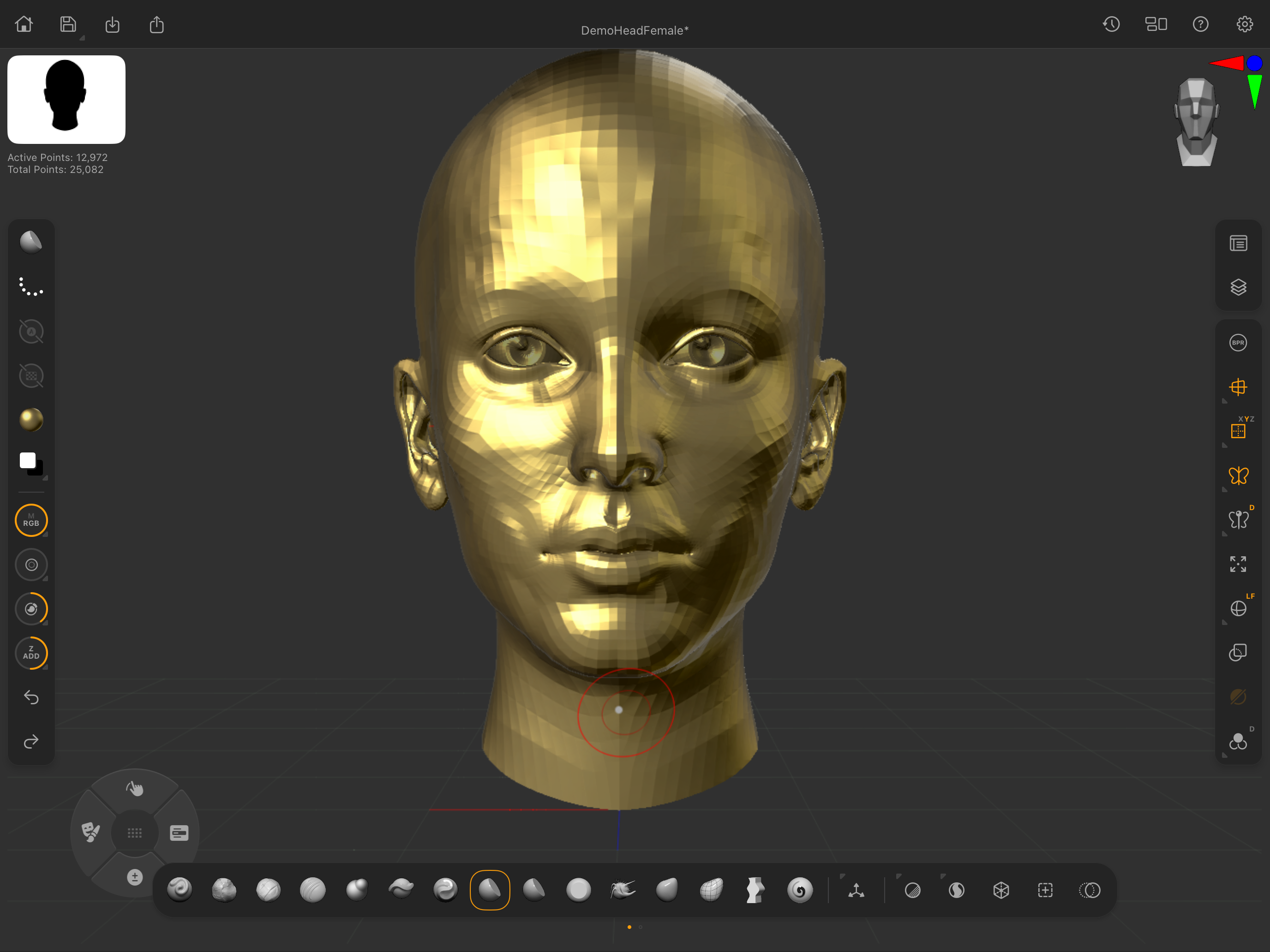
Although I’m not an artist of either the 2D or 3D kind, I checked out ZBrush, with is a 3D sculpting app. All the changes I made (using the Apple Pencil Pro) happened in real time, without a hint of lag. If I were artistically inclined, I’m sure I’d appreciate how intuitive this app is to use, which is no doubt possible because of the power of M5.
We couldn’t conduct our in-house Wi-Fi and Cellular testing in time for this review. However, I will revise this review once we’ve done that testing. I will say that making calls (something you can now finally do on iPad) and downloading files is both seamless and fast, based on my experience with the iPad Pro.
A beautiful OLED panel
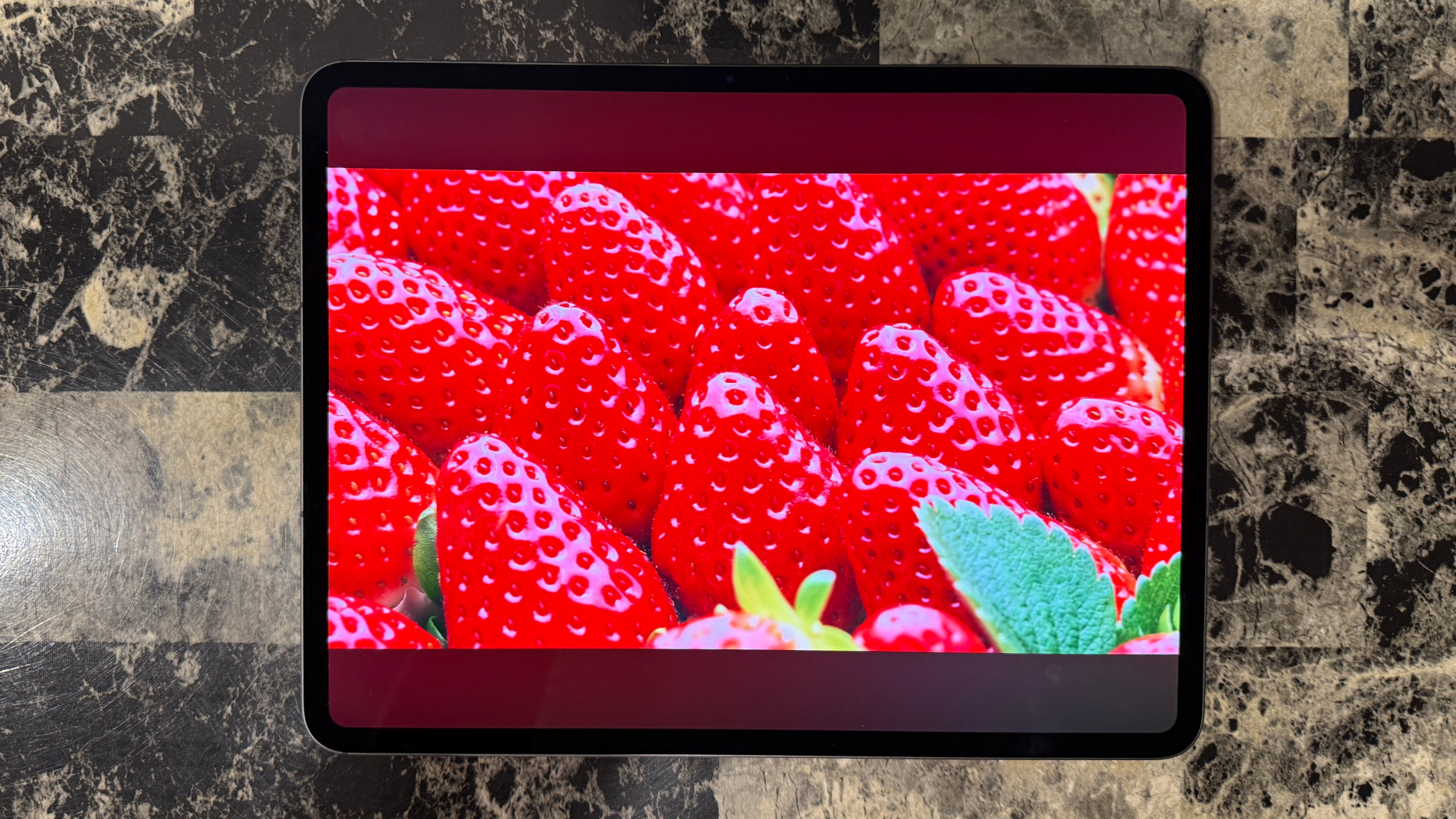
The iPad Pro M5’s OLED panel is a marvel to behold and is arguably my personal favorite feature. That’s not surprising given how much I loved the OLED panel on the previous model. The screen hasn’t received an update, which is fine since it still delivers inky blacks, eye-scorching brightness, and vivid colors. This is eye candy of the highest order.
To check out the iPad Pro’s image quality, I watched a YouTube video called “OLED Test 12K HDR 120fps” since it ticks all the right boxes. I was particularly impressed with a scene featuring strawberries since the reds really stood out. The image I snapped with my iPhone 16 Pro Max don't do the image justice. The iPad Pro’s 120Hz refresh rate matched the video’s frame rate, ensuring everything ran smoothly.
| Row 0 - Cell 0 | iPad Pro M5 | iPad Pro M4 | Galaxy Tab S11 Ultra |
Nits (brightness) | 561 (SDR) | 965 (HDR) | 561 (SDR) | 957 (HDR) | 401 (SDR) | 897 (HDR) |
sRGB | 116% | 117.4% | 157.3% |
DCI-P3 | 82.1% | 83.2% | 111.4% |
Delta-E | 0.27 | 0.29 | 0.25 |
Since the iPad Pro has the same display as last year’s model, we saw similar numbers in our display test. Color reproduction (sRGB and DCI-P3), color accuracy (Delta-E) and brightness (nits) are virtually identical. Given how incredible everything looks on the iPad Pro, I don’t mind that we didn’t see a stark difference in our testing.
How does the iPad Pro compare to its direct rival, the Samsung Galaxy Tab S11 Ultra? Samsung’s slate generally delivers oversaturated colors over the iPad Pro, but it doesn’t get nearly as bright when displaying HDR content. The iPad Pro has the edge since it gets brighter and delivers more natural hues.
Thin and light design
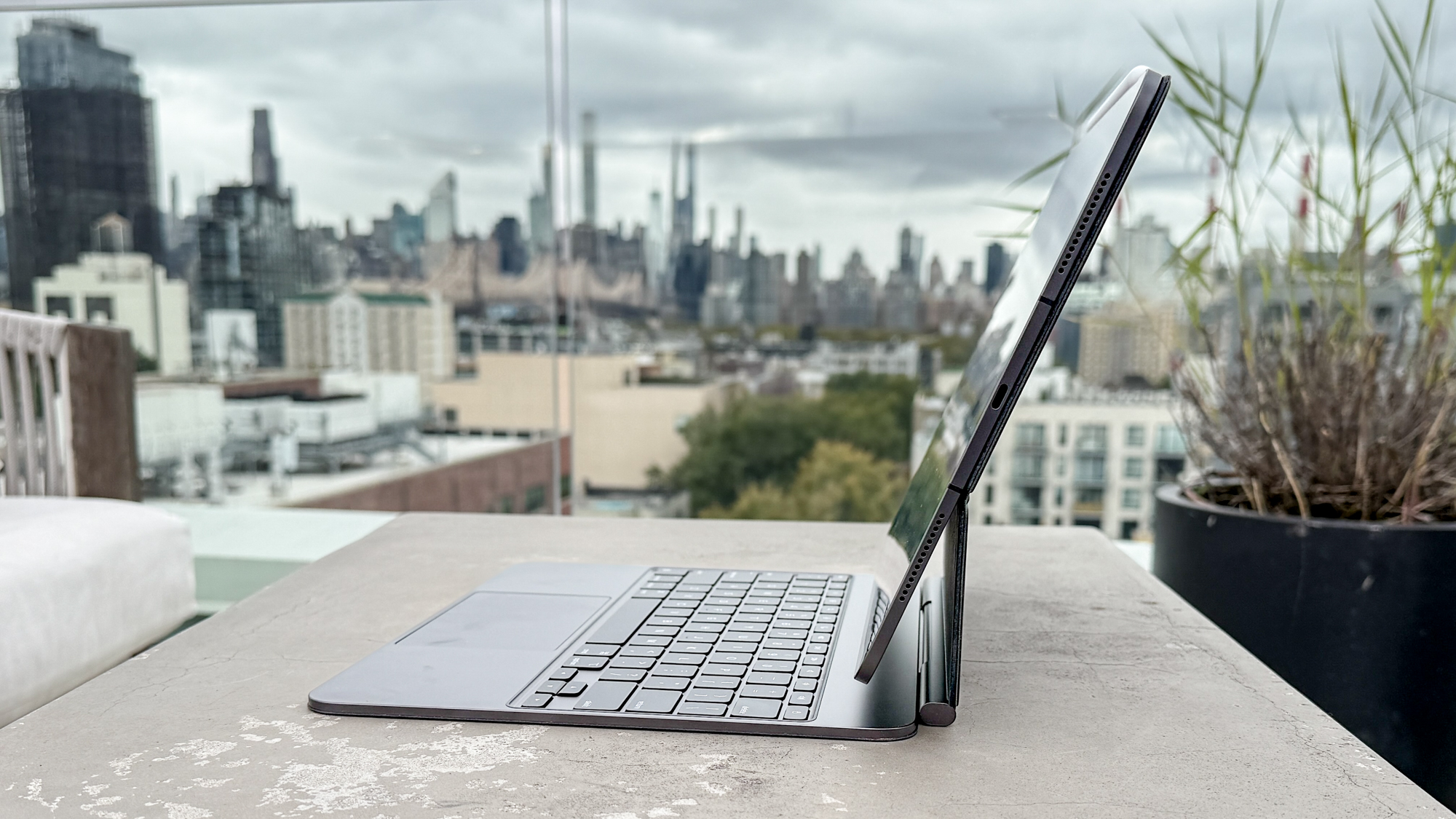
As with its OLED panel, the new iPad Pro retains the same design as the 2024 model. You get a sturdy piece of aluminum with a large display and super-slim profile. And like before, the iPad Pro is actually thinner and lighter than the iPad Air M3. Thanks to that, even the large 13-inch iPad Pro is comfortable to hold for long periods of time.
This is now the second iPad Pro featuring a landscape-oriented front camera, which is a big improvement over the portrait-oriented cameras of older iPads. If you like taking selfies on a tablet or frequently participate in video calls, you’ll certainly appreciate the camera’s position. Using FaceID to unlock the iPad Pro is also simple, thanks to the centered camera.
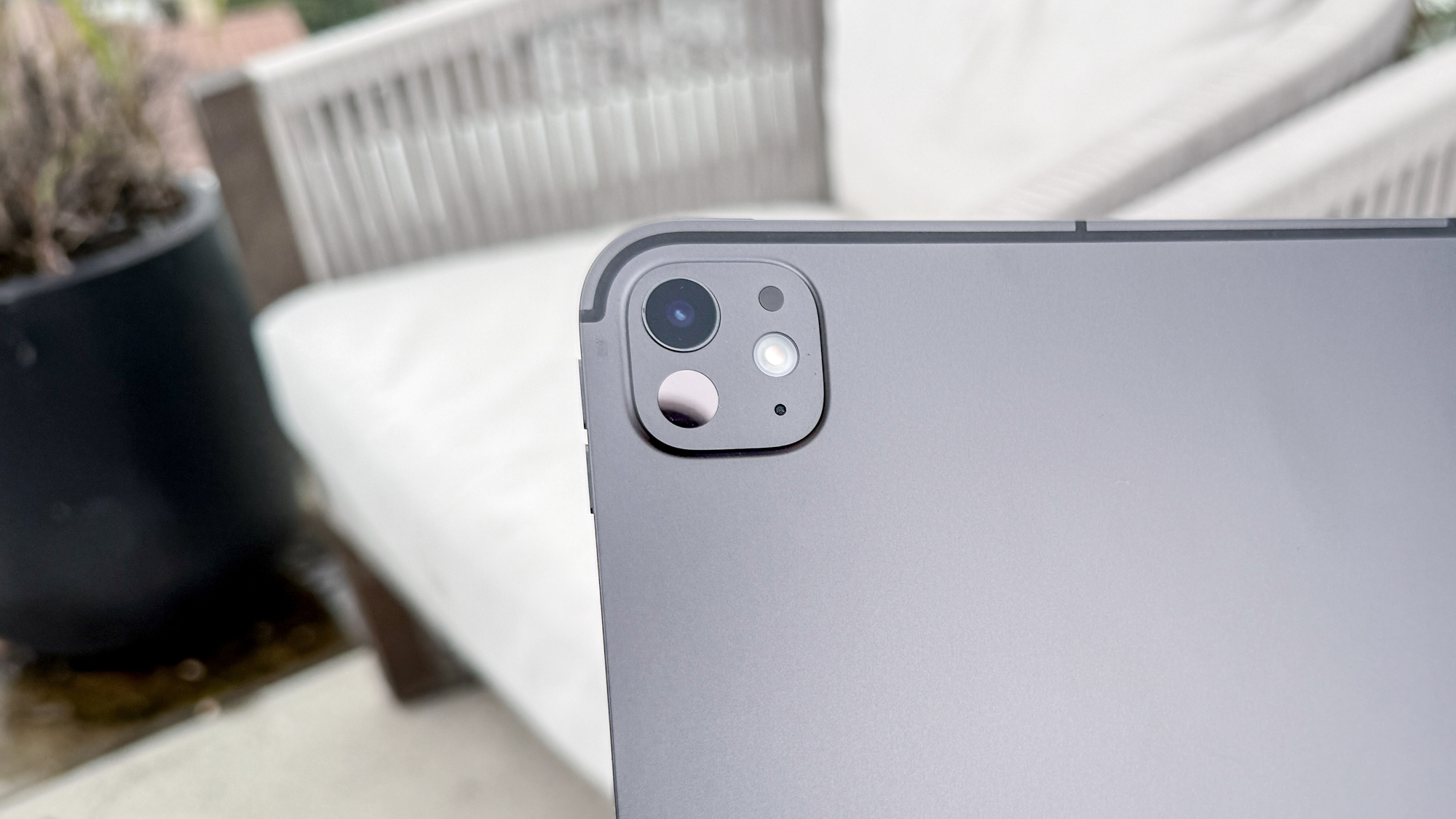
The buttons and ports remain the same. In landscape mode, the power button is located on the left side of the tablet, while the volume buttons are on the top left. There’s also a lone Thunderbolt/USB 4 port on the center right side, and four speakers flanking the tablet (two on the left, two on the right). And of course, there's also a 12MP camera on the back.
Apple sent us the Space Black iPad Pro, but there’s also a Silver model. It would have been nice if the iPad Pro had more color options like the iPad Air, but since I like dark colors on electronics, I can’t complain too hard—especially when Space Black looks so darn cool.
Long-lasting battery life
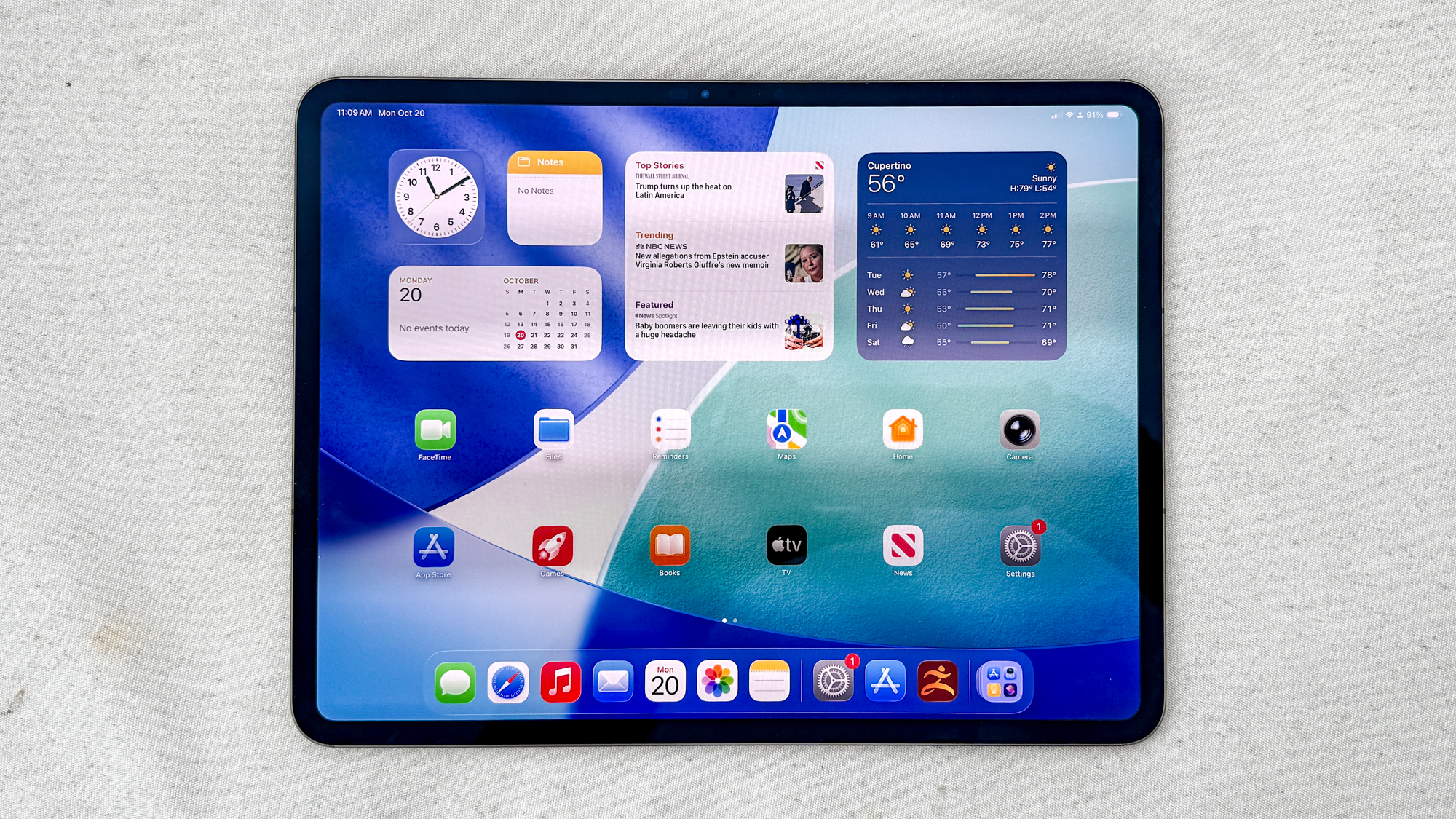
We only had time to run one battery test on the iPad Pro, so I’ll update this review once we’ve run at least two more tests. Nevertheless, the one battery test we did conduct reveals a tablet that can last well beyond a standard 8-hour workday.
| Row 0 - Cell 0 | Time (hours:mins) |
iPad Pro M5 | 13:18 |
iPad Pro M4 | 11:27 |
Galaxy Tab S11 Ultra | 12:03 |
In our battery test, which involved continuous web-surfing over Wi-Fi with the display set to 150 nits of brightness, the iPad Pro lasted for 13 hours and 18 minutes. That’s almost two hours longer than the previous model, and a little over three hours beyond Apple’s promised 10-hour claim. Apple’s tablet also outlasts the Samsung Galaxy Tab S11 Ultra, as you can see in the table above.
Again, I’ll update this review once we’ve finished our battery life tests. That said, I still expect the iPad Pro to have exceptional endurance.
iPad Pro M5 review: The downs
I don’t have any major complaints with the iPad Pro itself. Unfortunately, just like last year, my main gripes concern the price of specific upgrades and peripherals. While you could live without the former, the latter could be a major issue if you wanted to use the iPad Pro for work.
Pricey peripherals
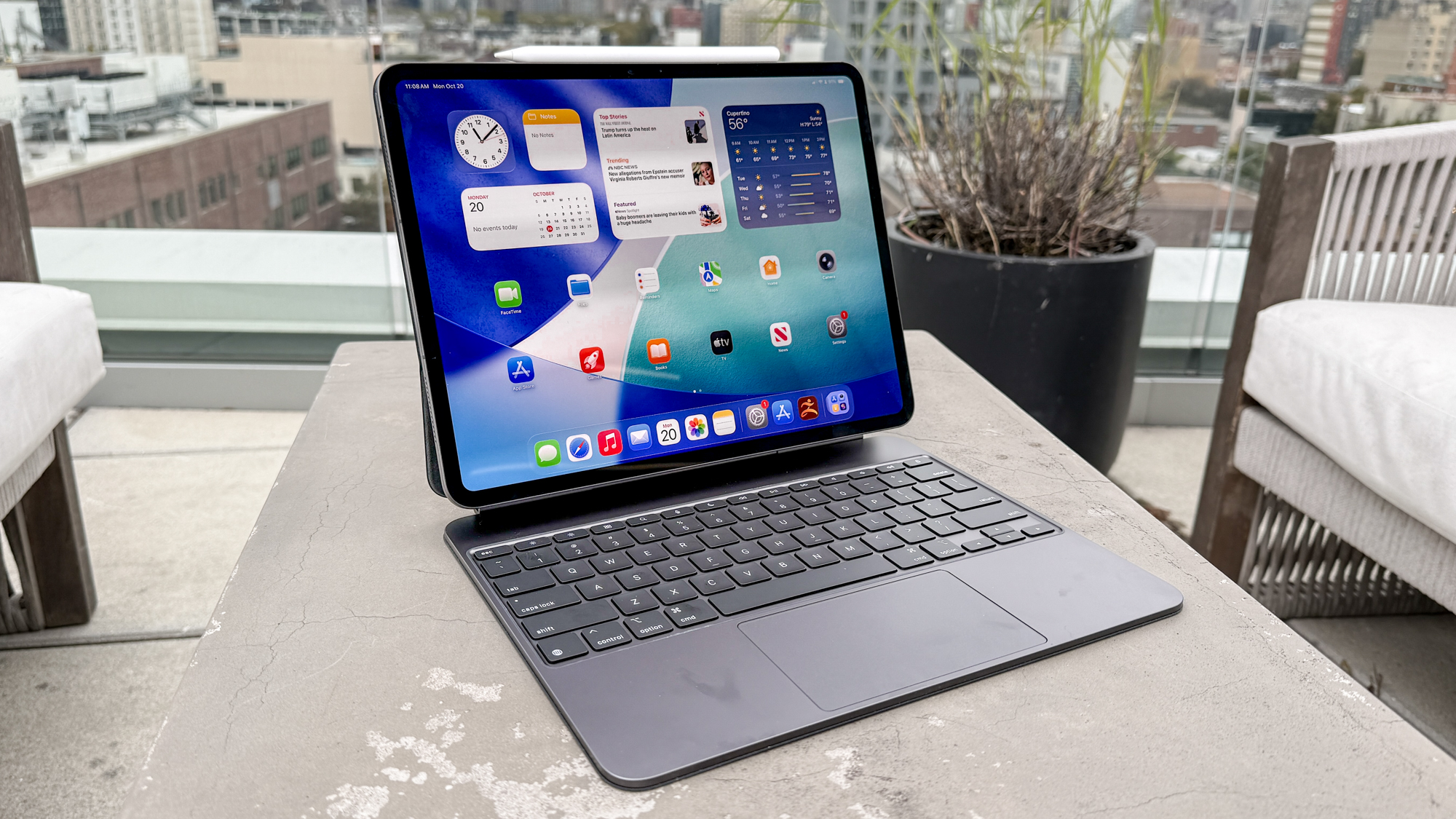
To get the most from the iPad Pro, you’ll need the Apple Magic Keyboard and Apple Pencil Pro. These peripherals haven’t been updated from last year, which isn’t bad considering how well they already function with the previous iPad Pro. Unfortunately, these peripherals still don’t come cheap.
The Apple Pencil Pro starts at $129, while the Magic Keyboard costs $299 for the 11-inch iPad Pro and $329 for the 13-inch model. To truly use the iPad Pro as a MacBook replacement, you’ll have to spend at least $1,648. At that price, you can instead get a 13-inch MacBook Air M4 for $999 (or lower, depending on sales).
As for the stylus, you can opt for the $79 Apple Pencil with USB-C. However, keep in mind that it doesn’t have Apple Pencil Pro features like barrel roll and can’t wirelessly charge when magnetically attached to the iPad Pro.
Despite their steep cost, the Apple Pencil Pro and Magic Keyboard are still fantastic iPad Pro peripherals. The former’s new features make it easy to use for drawing and writing, while the latter’s MacBook-like aluminum finish, thick keycaps, and larger touchpad make it a joy to type on. It’s just a bummer that these peripherals are still so expensive.
Nano-texture glass isn’t cheap
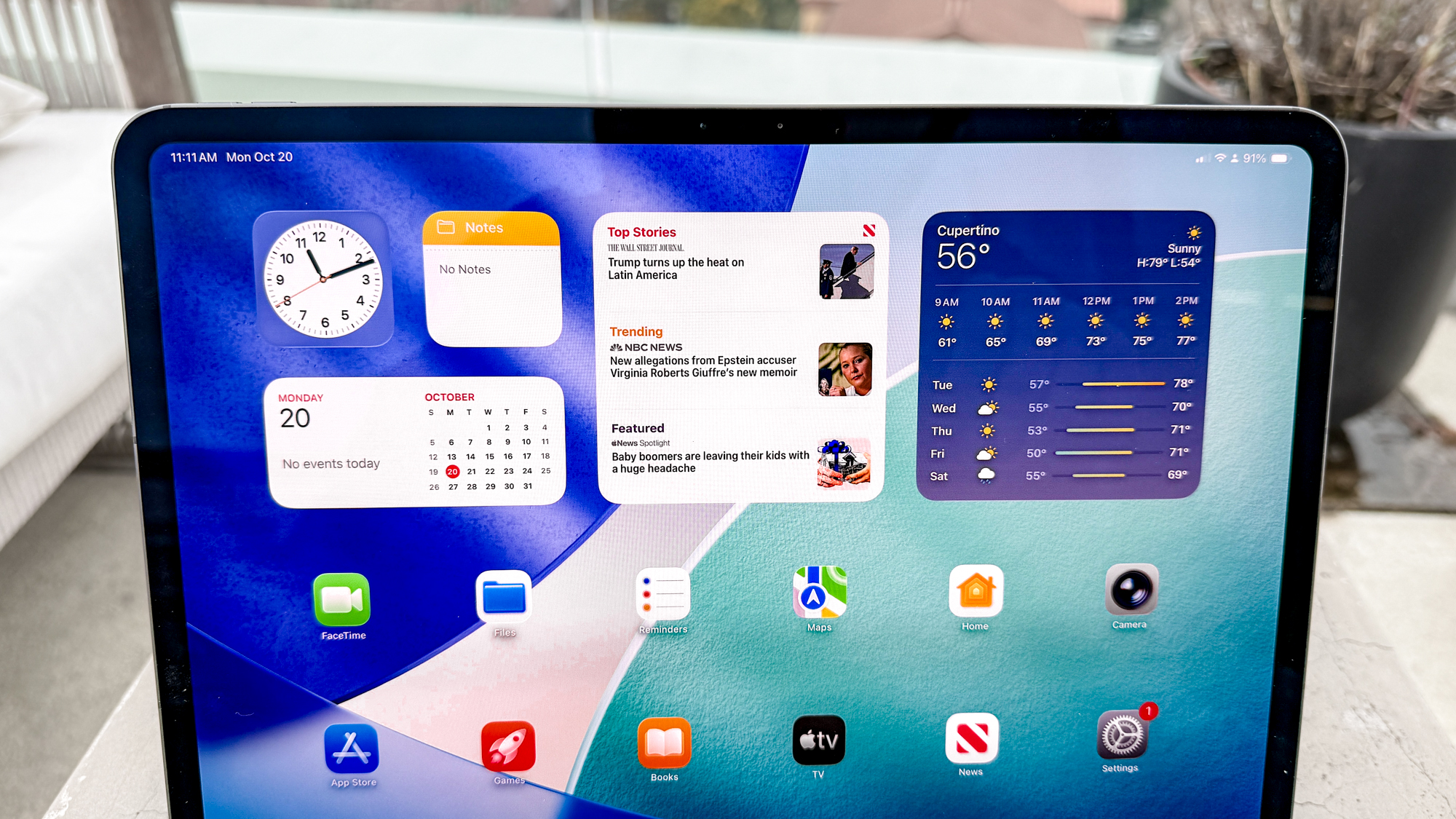
Apple offers a nano-texture glass option for both 11- and 13-inch iPad Pro models. This is a nice upgrade that can help minimize screen glare, especially if you work outdoors or somewhere with bright lights.
Paying $100 extra for nano-texture glass might not sound bad. However, this upgrade is only for pricier iPad Pro models with 1TB or 2TB of storage. Like before, upgrading to 1TB raises the price by $600 for both models. When adding nano-texture glass for $100, you’re actually paying $700 extra at a minimum.
Those who were already going to pay for 1TB or 2TB models won’t be affected too much by selecting nano-texture glass. However, the average person arguably doesn’t need a lot of storage space, so spending all that extra money for an anti-glare screen will definitely sting.
iPad Pro M5 review: Verdict
Apple redesigned the iPad Pro last year, so I’m not surprised we didn’t get a major overhaul with the M5 model. While that means you don’t need to upgrade if you own the M4 iPad Pro, it’s certainly worthwhile if you own an iPad Pro M2 or older. Apple has once delivered a truly premium device that offers exceptional performance, battery life, and a stunning OLED panel.
Your milleage may vary with Apple Intelligence. Features like Math Notes and Smart Scripts can be useful if you’re a math student or enjoy writing by hand (respectively), but if you’re not, these features could be superfluous. However, iPadOS 26’s more MacBook-like UI and window controls make the iPad Pro a more feasable MacBook replacement—if you’re willing to spend extra for the Magic Keyboard.
Price peripherals and upgrades aside, the iPad Pro M5 is a phenomenal Apple tablet that can do just about anything. Right now, it’s my favorite tablet and one that will likely retain that distinction for the foreseeable future. If you’re looking for a top-tier slate, you won’t go wrong with the iPad Pro M5.

Tony is a computing writer at Tom’s Guide covering laptops, tablets, Windows, and iOS. During his off-hours, Tony enjoys reading comic books, playing video games, reading speculative fiction novels, and spending too much time on X/Twitter. His non-nerdy pursuits involve attending Hard Rock/Heavy Metal concerts and going to NYC bars with friends and colleagues. His work has appeared in publications such as Laptop Mag, PC Mag, and various independent gaming sites.
You must confirm your public display name before commenting
Please logout and then login again, you will then be prompted to enter your display name.
